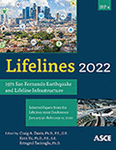Evaluating the Impact of Equipment Selection on Debris Removal and Dependent Lifeline Infrastructure Recovery
Publication: Lifelines 2022
ABSTRACT
Debris removal is a critical activity in the aftermath of natural disasters such as earthquakes and tsunamis to enable community and lifeline network recovery. This activity is hampered by logistical bottlenecks including the non-availability of equipment and inadequate capacity of temporary debris management sites (TDMS). This paper enables analysis of debris removal and lifeline repair operations quantifying recovery times for informed decision-making about equipment allocation and TDMS selection before the disaster. The developed framework was applied to the case study of a Cascadia Subduction Zone event for the coastal town of Astoria in Oregon. The proposed framework enables decision-makers with an objective means of evaluating decision alternatives both before and after disasters to analyze and improve their community’s capability of handling disaster debris. Furthermore, this framework will serve as a platform upon which interdependencies between transportation network and debris removal operations will be analyzed in the future.
Get full access to this article
View all available purchase options and get full access to this chapter.
REFERENCES
Abiri, B., Louis, J., and Riggio, M. (2019). Decision-making for Cross-Laminated Timber Modular Construction Logistics Using Discrete Event Simulation. Modular and Offsite Construction (MOC) Summit Proceedings, 381-388.
Brown, C., Milke, M., and Seville, E. (2011). Disaster waste management: A review article. Waste management, 31(6), 1085-1098.
Brown, C., and Milke, M. W. (2009). Planning for disaster debris management. Caterbury, New Zealand.
FEMA. (2007). Public assistance. Debris management guide. Federal Emergency Management Agency (FEMA), Washington. Federal Emergency Management Agency, July, 260. www.fema.gov/pdf/government/grant/pa/demagde.pdf%0Ahttp://www.fema.gov/government/grant/pa/demagde.shtm.
FEMA. (2018). Hazus | FEMA.gov. FEMA. https://www.fema.gov/hazus.
Fetter, G., and Rakes, T. (2012). Incorporating recycling into post-disaster debris disposal. Socio-Economic Planning Sciences, 46(1), 14-22.
Ford, P. (2011). Japan tackles mountains of trash left in tsunami’s wake. https://www.csmonitor.com/World/Asia-Pacific/2011/0715/Japan-tackles-mountains-of-trash-left-in-tsunami-s-wake.
Habib, M. S., and Sarkar, B. (2017). An integrated location-allocation model for temporary disaster debris management under an uncertain environment. Sustainability, 9(5), 716.
Hu, Z. H., and Sheu, J. B. (2013). Post-disaster debris reverse logistics management under psychological cost minimization. Transportation Research Part B: Methodological, 55, 118-141.
Jackson, N. M. (2008). Cleaning up after mother nature. Waste Age, 3.
Kim, J., Deshmukh, A., and Hastak, M. (2014). Selecting a Temporary Debris Management Site for Effective Debris Removal. In Randy R. Rapp & William Harland (Eds.), The Proceedings of the 10th International Conference of the International Institute for Infrastructure Resilience and Reconstruction (I3R2) 20-22 May 2014. (214-218). West Lafayette, Indiana: Purdue University.
Lorca, Á., Çelik, M., Ergun, Ö., and Keskinocak, P. (2015). A decision-support tool for post-disaster debris operations. Procedia Eng, 107, 154-167.
Louis, J., and Dunston, P. (2016). Platform for real time operational overview of construction operations. In Construction Research Congress 2016 (pp. 2491-2501).
Louis, J., and Dunston, P. S. (2018). Integrating IoT into operational workflows for real-time and automated decision-making in repetitive construction operations. Automation in Construction, 94, 317-327.
Louis, J., Dunston, P., and Martinez, J. (2014). Simulating and visualizing construction operations using robot simulators and discrete event simulation. In Computing in Civil and Building Engineering (2014) (pp. 355-363).
Louis, J., and Dunston, P. (2014). Modified Discrete Event Simulation Algorithm for Control of Automated Construction Operations. In ISARC. Proceedings of the International Symposium on Automation and Robotics in Construction (Vol. 31, p. 1). IAARC Publications.
Louis, J. (2010). Impact of lighting on the safety and productivity of nighttime construction workers. Purdue University, West Lafayette, IN.
Martinez, J. C. (1996). STROBOSCOPE: State and resource based simulation of construction processes (Doctoral dissertation). University of Michigan, Ann Arbor, MI.
Martinez, J. C. (2010). Methodology for conducting discrete-event simulation studies in construction engineering and management. Journal of Construction Engineering and Management, 136(1), 3-16.
Mostafavi, A., Valentin, V., Abraham, D. M., and Louis, J. (2012). Assessment of the productivity of nighttime asphalt paving operations. Journal of construction engineering and management, 138(12), 1421-1432.
OSSPAC. (2013). The Oregon Resilience Plan. February, 341.
Shitole, V., Louis, J., and Tadepalli, P. (2019, December). Optimizing earth moving operations via reinforcement learning. In 2019 Winter Simulation Conference (WSC) (pp. 2954-2965). IEEE.
Watson, J. T., Gayer, M., and Connolly, M. A. (2007). Epidemics after natural disasters. Emerging infectious diseases, 13(1), 1.
Yepsen, R. (2008). Generating biomass fuel from disaster debris. Biocycle, 49(7), 51-55.
Information & Authors
Information
Published In
History
Published online: Nov 16, 2022
Authors
Metrics & Citations
Metrics
Citations
Download citation
If you have the appropriate software installed, you can download article citation data to the citation manager of your choice. Simply select your manager software from the list below and click Download.
